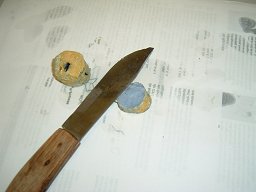Sodium, Potassium - Experiments
The elements of the first main group - hydrogen, lithium, sodium, potassium, rubidium, caesium and francium - are called alkali metals.
They have only one electron in the outermost electron shell, which they can easily pass on to another element. As a result, they are extremely reactive.


Therefore, are kept in paraffin for safety reasons.sodium (left) and potassium (right)in Paraffinöl aufbewahrt:

Pure sodium and potassium ave a silvery or bluish appearance. When exposed to the air, they turn yellowish first before they acquire a grey-brown, rotten-looking appearance from the oxidation processes.

1. Experiment:
 Sodium and potassium are metals, which are so soft that they can be cut with a knife!
Sodium and potassium are metals, which are so soft that they can be cut with a knife!



2. Experiment:
Since an explosion might occur, our 'assistant', Verena, carried out this experiment in the fume cupboard.
She filled a big glass bowl with water, stirred in a few drops of colourless phenolphthalein and mixed the solution well.
Afterwards, she threw a small, carefully peeled piece of sodium into the water: The piece of sodium sizzled and danced on the water’s surface and the water turned pink!

Explanation
Gaseous hydrogen is formed around the piece of sodium and so it dances on the water surface like a drop of water on a hot surface, which is covered by a film of water vapour. The phenolphthalein in the water turns pink, because sodium hydroxide is formed.
Sodium is very dangerous, as it may even flare up when in contact with 'harmless' water vapour, especially when the brown coating that sodium normally forms when exposed to air is removed.
 Matter
Matter  Metals
Metals  The First Main Group - Alkali Metals
The First Main Group - Alkali Metals  Sodium, Potassium - Experiments
Sodium, Potassium - Experiments 

 Matter
Matter  Metals
Metals  The First Main Group - Alkali Metals
The First Main Group - Alkali Metals  Sodium, Potassium - Experiments
Sodium, Potassium - Experiments 
